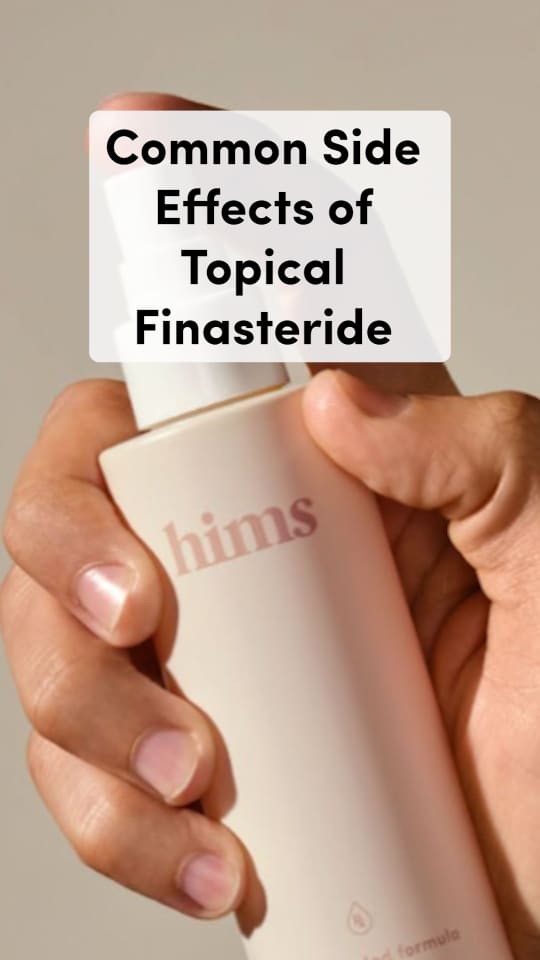
Once you hit the age of 50, several things, both good and bad, happen. You’re eligible to sign up for AARP, you can use the excuse “I’m too old” to get out of things and there’s a good chance you’ll be experiencing some degree of hair loss.
The most common form of hair loss, male pattern baldness (also called androgenetic alopecia or AGA) affects up to 50 percent of men by age 50. Welcome to the club!
Fortunately, there are ways to treat male pattern baldness. The oral medication finasteride (brand name Propecia®) is a common recommendation and is one of two FDA-approved medications for the treatment of androgenetic alopecia.
But oral finasteride has known sexual side effects like decreased libido and erectile dysfunction from the oral tablet, so using a topical finasteride treatment could be a preferable alternative for some people.
However, topical finasteride has yet to receive FDA approval and there’s very limited research on its benefits or even how it works. That all leads to some pressing questions that need to be answered: Does topical finasteride have side effects? And perhaps more importantly, is topical finasteride safe?
Are There Side Effects of Topical Finasteride?
Every medication can have potential side effects. If you’ve ever looked up finasteride side effects, you may have seen common adverse effects like sexual dysfunction, reduced ejaculation, or even insomnia from finasteride. However, these are most often from oral finasteride (and are rare).
“Oral finasteride is one of only two FDA-approved medications for hair loss, the other being topical minoxidil, and a lot of independent data shows its effectiveness,” says Knox Beasley, MD, a board-certified dermatologist and one of our medical reviewers. “I always discuss the potential side effects of finasteride. However, the risk of sexual side effects is very low."
Topical finasteride, on the other hand, is more likely to cause irritation to the skin at the point of application because it’s applied directly to skin.
When it comes to finasteride side effects, it’s important to understand how then medication works. Finasteride belongs to a group of medications called 5-alpha reductase inhibitors. These medications prevent the conversion of testosterone to dihydrotestosterone, which can prevent further hair loss.
The most common form of hair loss, male pattern baldness (also called androgenetic alopecia or AGA), affects up to 50 percent of men by age 50. High DHT levels cause the hair follicles — the tiny organs throughout your scalp from which your hair grows — to shrink, leading to baldness.
The receding hairline or thinning hair that signals hair loss is caused by enzymes that convert testosterone into the male sex hormone dihydrotestosterone (DHT), a major androgen.
Finasteride can stop this, though it does include side effect risks.
The Side Effects of Topical Finasteride
While oral finasteride takes effect through systemic absorption (absorption by every part of the body—skin, hair, liver, etc.), the topical formulation provides localized treatment just on the scalp.
Topical finasteride is not specifically FDA-approved for hair loss, though it’s widely used for this purpose. Research from 2022 suggests that while topical finasteride is not FDA-approved like its oral counterpart, it does not have the same potential for systemic side effects.
Side effects of topical finasteride will typically be topical, too. And depending on the topical format, they can vary slightly.
Finasteride Solution Side Effects
A clinical study that compared the effects of oral finasteride against a finasteride 0.25% topical solution was carried out on 24 men with androgenetic alopecia.
The men from the clinical trial who applied the topical finasteride solution to their scalps for one week showed similar results to those who took 1mg of oral finasteride for the same amount of time. Specifically, scalp DHT was reduced by 68 to 75 percent when topical finasteride was used, compared to 62 to 72 percent with the oral tablet. Researchers also found that the topical solution was well-tolerated.
Another study in the Indian Journal of Dermatology compared the effects of topical finasteride gel to the oral tablet form on 45 male androgenetic alopecia patients. The patients used the gel twice daily for six months, while the finasteride tablets were used once daily.
By the end of the study, both groups saw similar positive effects on hair growth.
Finasteride Spray Side Effects
A study of more than 440 patients that looked at the effectiveness of a topical finasteride spray compared to the oral tablet found that the spray significantly improved hair count compared to placebo, but had less of an impact on serum DHT levels than the oral version.
While all these studies show promising results for the effectiveness of topical finasteride, many are too small to gauge if a finasteride spray can really encourage hair regrowth.
But what about topical finasteride spray side effects or adverse effects of a finasteride gel?
Topical finasteride, like all medications, can lead to some side effects. But many of these studies reported that the hair loss treatment was well-tolerated, with a few minor side effects, including:
Lightheadedness
Headaches
Redness at the application site
Scalp itching
Irritation
Serious Topical Finasteride Side Effects
Although much rarer, serious side effects are possible. For example, two subjects in the first study reported increased levels of alanine transaminase — a dangerous situation for the liver with high, frequent daytime urination and testicular pain.
And while we can appreciate a moment of craftiness, we have to urge you not to make your own topical finasteride.
Will you join thousands of happy customers?
4.5 average rating
Is Topical Finasteride Safe to Use with Other Hair Loss Products?
Men and women frustrated with hair loss have an abundance of hair restoration options available, from hair transplants and laser treatments to other medications.
Some may wonder if topical finasteride is safe when used with other hair loss treatments. The short answer is yes, sometimes. However, you should seek medical advice for the treatment of androgenetic alopecia before combining any treatments on your own.
One of the safest options is minoxidil, the other medication approved by the FDA for male pattern hair loss.
Minoxidil, a topical solution, stimulates hair growth by encouraging blood flow to your hair follicles. Minoxidil is also thought to lengthen the growth phase of your natural hair growth cycle.
In a study testing the effectiveness of a treatment that combined topical finasteride, dutasteride (another 5-alpha reductase inhibitor), and topical minoxidil, 15 male patients applied a mix of these products for nine months.
Those who used the topical finasteride treatment, dutasteride, and minoxidil solution saw hair growth after three months. This combination was well-tolerated, even in patients with a tendency for allergies.
Hair loss treatments, delivered
Topical Finasteride Side Effects: Takeaways
While FDA-approved to treat male hair loss, oral finasteride can cause side effects like sexual dysfunction. Therefore, some may opt for a topical finasteride treatment option to reduce the risk of those systemic side effects.
But is topical finasteride safe, and what side effects can you expect? Here’s what you need to know.
Finasteride works to block the conversion of testosterone into the hormone dihydrotestosterone (DHT), which causes male pattern baldness. While often prescribed as an oral tablet, topical finasteride solutions are available (but not FDA-approved).
While there haven’t been any large studies of the effects of topical finasteride, multiple smaller studies have shown that it significantly improved hair count and hair density, with a lower risk of side effects.
There can be some side effects of topical finasteride, though, including irritation, an itching or burning sensation, lightheadedness, or redness where the solution is applied.
Our full guide explains topical finasteride use, including application and safety measures. We’ve also discussed its effectiveness and the side effects of oral finasteride in depth.
If you want to explore more hair loss treatments, start by connecting with a dermatologist or healthcare provider today.
If you’re looking for a combination solution to treat hair loss, we offer a topical finasteride & minoxidil spray.
Or you can try minoxidil on its own, available as either a minoxidil foam or liquid minoxidil solution drops, both of which are applied directly to the scalp.
If you’re looking for more ways to encourage hair growth or boost thin hair, adding supplements like biotin gummies can lead to a fuller head of hair.
You can also try hair products like a thickening shampoo with saw palmetto or this volumizing shampoo and conditioner duo for thinning hair to give your locks some lift.
7 Sources
- AAD. (n.d). Hair loss: Diagnosis and treatment. https://www.aad.org/public/diseases/hair-loss/treatment/diagnosis-treat
- Akgündüz MÇ, et al. (2020). The potential risk assessment of phenoxyethanol with a versatile model system. https://pmc.ncbi.nlm.nih.gov/articles/PMC6985251/
- BinJadeed H, et al. A case of contact allergic dermatitis to topical minoxidil. https://pmc.ncbi.nlm.nih.gov/articles/PMC7861115/
- Lee SW, et al. (2018). A systematic review of topical finasteride in the treatment of androgenetic alopecia in men and women. https://pmc.ncbi.nlm.nih.gov/articles/PMC6609098/
- Oura H, et al. (2019). Adenosine increases anagen hair growth and thick hairs in Japanese women with female pattern hair loss: a pilot, double-blind, randomized, placebo-controlled trial. https://pubmed.ncbi.nlm.nih.gov/19239555/
- Rafi AW, et al. (2011). Pilot study of 15 patients receiving a new treatment regimen for androgenic alopecia. https://pmc.ncbi.nlm.nih.gov/articles/PMC3262531/
- Suchonwanit P, et al. (2019). Minoxidil and its use in hair disorders: a review. https://pmc.ncbi.nlm.nih.gov/articles/PMC6691938/
Editorial Standards
Hims & Hers has strict sourcing guidelines to ensure our content is accurate and current. We rely on peer-reviewed studies, academic research institutions, and medical associations. We strive to use primary sources and refrain from using tertiary references. See a mistake? Let us know at blog@forhims.com!
This article is for informational purposes only and does not constitute medical advice. The information contained herein is not a substitute for and should never be relied upon for professional medical advice. Always talk to your doctor about the risks and benefits of any treatment. Learn more about our editorial standards here.
